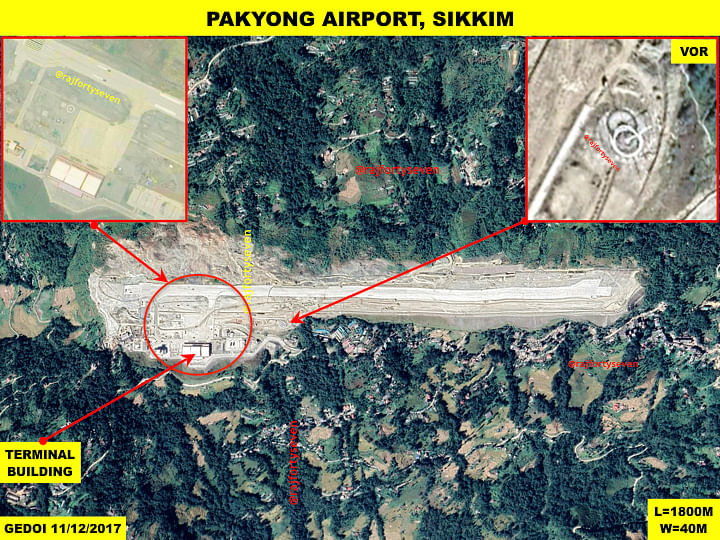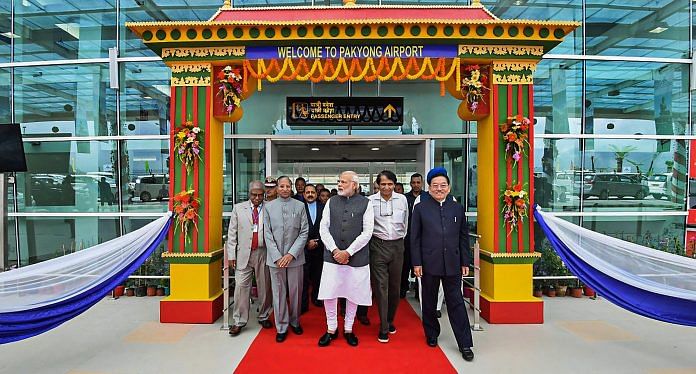Through the ‘look northeast’ policy, BJP hopes to expand influence in region not known as its stronghold as it heads into poll season.
New Delhi: Prime Minister Narendra Modi’s move to launch Sikkim’s first airport in Pakyong Monday became yet another step in Bharatiya Janata Party’s systematically crafted northeast strategy to expand and firmly entrench its presence in the region.
Dedicating the airport to the nation, Modi said his government was committed to making the northeast an “engine of India’s growth story”.
Modi, who flew to Gangtok straight from Jharkhand Sunday after launching health scheme Ayushman Bharat, was “particular about inaugurating the airport himself” in order to send out the right message, said highly placed sources in the party.
“For the first time since Independence, stress has been given on increasing connectivity by both air and rail, electricity in remote areas of the northeast and building infrastructure,” Modi said at the inauguration Monday.

Target northeast
The optics of the prime minister inaugurating the airport and the import of his government’s northeast policy are evidently a part of the BJP’s ‘look northeast plan’.
The northeast has traditionally been far from a stronghold for the party, but ever since it came to power at the Centre in 2014, it has gradually asserted itself in the region. It managed to come to power in six of the eight northeastern states — Assam, Manipur, Arunachal Pradesh, Tripura, Meghalaya and Nagaland — either by winning elections or forging alliances.
One of the two remaining states in the region — Mizoram — goes to polls end of this year.
ThePrint reported in May that the party began its groundwork in the state much earlier this year, with a full-fledged team stationed there ever since February.
Also read: BJP has begun plotting how it can win over the seventh, and last, sister of the northeast
The strategy
The BJP has been keen on spreading its wings in the northeast for two primary reasons. One, it hopes the expansion will help it garner more seats in the 2019 Lok Sabha elections from hitherto virgin territories, said sources. Two, it helps the BJP establish itself as a pan-India party, which goes beyond Hindi-speaking regions and has acceptability even in other societies despite its overtly religious stand and a vexed stand on issues such as eating beef.
The BJP is aware it would lose a significant number of seats in the northern and western region in the forthcoming Lok Sabha polls, compared to 2014, and hopes to compensate that to some extent through the northeastern as well as eastern states.
The northeastern states together account for 25 Lok Sabha seats, of which the BJP currently has only eight. Meanwhile, Odisha and West Bengal in the east have 21 and 42 seats, respectively. Thus, the east and northeast together have as many as 88 Lok Sabha seats, of which the BJP currently has only 11.
Also read: How a Modi govt innovation is taking air-connectivity to small-town India
Party president Amit Shah had planned on giving special attention to the roughly 120 Lok Sabha seats the party lost, mostly spread across the south, east and northeast, in 2014.
The party believes infrastructure initiatives like air and rail connectivity will go a long way in helping it find resonance among the region’s voters. The optics of the prime minister addressing vital events there helps magnify the message across the region.
Moreover, that alliances are crucial to BJP’s northeast strategy was clear given Modi did not attack the ruling Sikkim Democratic Front, even as he charged against the Biju Janata Dal (BJD) during a public address in Odisha Saturday.



